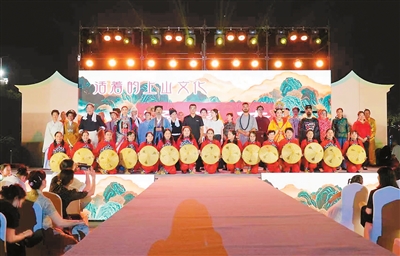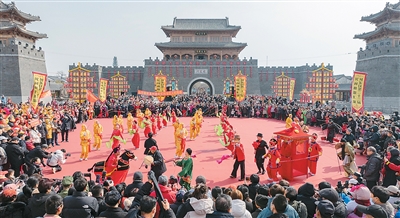




- BRNN
- BRI News
- BRNN News
- Database
Official Documents Polices and Regulations
Inter-government Documents International Cooperation BRI Countries
Business Guide Economic Data BRI Data
Trade
Investment Projects Latest projects
Cases - Content Pool

Photo shows a scene from the first original cultural tourism drama by the Jinhua Economic and Technological Development Zone in Jinhua, east China's Zhejiang Province, allowing residents and visitors to experience over 10,000 years of the practice of rice cultivation. (Photo/Yu Xiabing)
China's tourism performances generated over 13 billion yuan ($1.83 billion) in box office revenue during the first three quarters of this year, indicating robust development momentum, said Liu Kezhi, president of the China Association of Performing Arts, at a high-quality development conference on tourism performances held on Oct. 29.
In recent years, as culture and tourism have become increasingly integrated nationwide, many acclaimed and commercially successful tourism performance projects have emerged. The trend of "entering scenic areas to watch shows" is attracting growing numbers of visitors to both emerging destinations and traditional sites to discover new experiences.
Today's tourism performances have evolved far beyond simple entertainment at tourist attractions. They now serve as important vehicles for telling cultural stories, promoting in-depth culture-tourism integration, stimulating cultural and tourism consumption, and advancing comprehensive rural revitalization.
At Tang Paradise, a complex built on the site of an imperial garden dating back to the Tang Dynasty (618-907) in Xi'an, northwest China's Shaanxi Province, a spectacular performance unfolds as an actor recites "Qiang Jin Jiu" (Bring in the Wine), a famous poem by Li Bai, one of the greatest poets of the dynasty. Following the recitation, visitors can spot Li Bai aboard a small boat gliding across a lake.

Tourists watch a performance at the Yongning Gate of the ancient city wall in Xi'an, northwest China's Shaanxi Province. (Xinhua/Zhang Bowen)
"Lights projected onto a landmark tower before us, combined with a stunning water screen display, felt like stepping into a time tunnel," said Li Chen, a visitor from north China's Shanxi Province, who was immersed in the large-scale dance and light show "Chasing Dreams in the Tang Dynasty."
"We blend the culture of the Tang Dynasty's golden age with technological innovation and immersive experiences to build a tangible dreamscape of the dynasty," said Zhao Bin, performance management department manager at Tang Paradise.
Zhao sees the performance as breaking traditional stage boundaries by transforming the lake into a "natural stage" where spectators aboard boats become "dream seekers," immersed in the show.
"We have broken traditional viewing boundaries, giving visitors an immersive experience as if they were traveling through a painting," Zhao added. The show stages more than 150 performances annually on average, collectively attracting over 1 million visitors.
In Xi'an, the tourism performance boom continues with productions such as "The Great Qin," a stage play inspired by the epic history of the Qin Dynasty (221-206 B.C.); the musical "Sound of the Silk Road"; and the dance drama "The Song of Everlasting Sorrow," which depicts the tragic romance between Emperor Xuanzong of the Tang Dynasty and his concubine Yang Yuhuan.
These shows invite visitors to explore the ancient capital in new and engaging ways. In 2024, the city's 21 premium tourism performances were staged nearly 36,000 times and drew more than 16 million tourist visits, according to official data.
In Langya Ancient City, a scenic area in Linyi, east China's Shandong Province, the excitement continues after dark. As night deepens, visitors show no signs of slowing down, gathering before the stage for a show. During the 25-minute performance, waterfalls, fire displays, molten iron fireworks and light effects leave visitors breathless.

Visitors watch a traditional yangge dance performance held in Langya Ancient City, a scenic area in Linyi, east China's Shandong Province. (People's Daily/Wang Hui)
"The stage before me brings an ancient historical story to life, while behind me stand neatly arranged antique-style buildings and streets filled with classical charm. Watching a performance in such a setting truly makes me feel immersed in the story," said Pan Chuxiang, a visitor from Shanghai.
On the last weekend of October, Chen Jie from Xuzhou, east China's Jiangsu Province, visited Langya Ancient City for the second time to make up for missing a show titled "Guoxiu Langya" during the National Day holiday. The production depicts Linyi's history spanning thousands of years.
"Before watching the show, I knew nothing about Meng Tian's connection to Linyi," said Chen, who shared clips online of the character Meng Tian, a general from the Qin Dynasty, receiving numerous likes and comments.
This six-act show centers on Langya culture. By August, it had generated over 220 million yuan in performance revenue since premiering on Feb. 10, 2024, becoming a blockbuster in Linyi's cultural tourism sector and offering visitors an important gateway to local culture.
On Oct. 27, the show was included in the provisional list for the second batch of national excellent tourism performances by the Ministry of Culture and Tourism.
The show was staged more than 660 times in 2024, offering nearby residents opportunities to enjoy high-quality arts. Its production company has regularly organized free professional training and educational tour activities, benefiting over 1 million community residents annually.
Meanwhile, Langya Ancient City — where the performances take place — has directly provided over 1,200 jobs, raising local income by nearly 8 million yuan. It has also spurred the opening of more than 110 new hotels, bed-and-breakfasts, restaurants, specialty food vendors, guochao shops (which blend modern design with traditional Chinese cultural elements), and stores showcasing intangible cultural heritage around the scenic area.
This initiative has created about 3,000 direct jobs and generated roughly 5,000 indirect job opportunities, resulting in an additional income of around 25 million yuan and effectively driving regional economic growth.
"Increasingly popular tourism performances have become a new field for tourism sector development," Liu said.

Tel:86-10-65363107, 86-10-65368220, 86-10-65363106